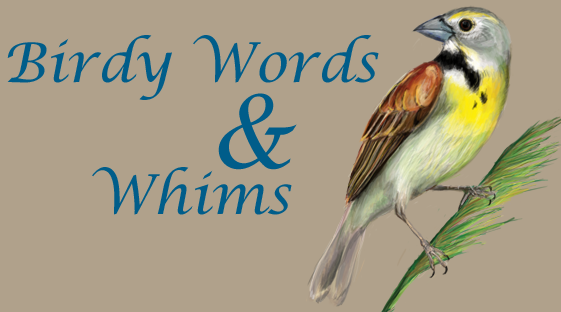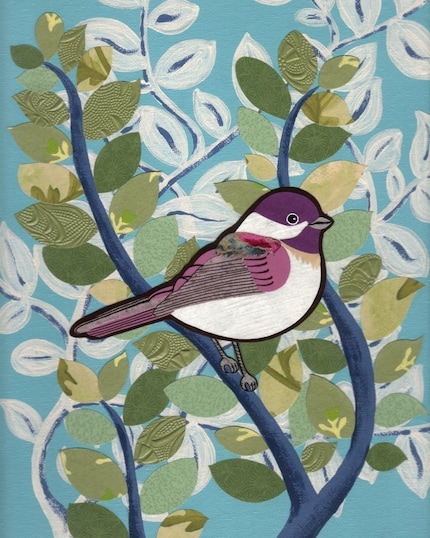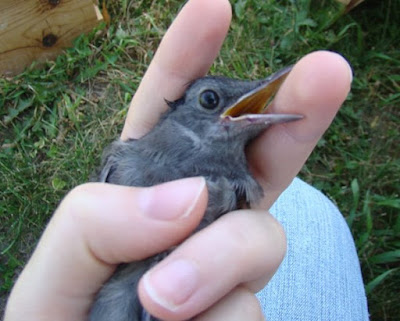
This past Saturday was a great day for banding. As soon as we started putting up nets, we could tell that we would be catching a lot of wrens, and we did! 11 total House Wrens were banded in 4 hours. They were really active in the area and had taken over all three nest boxes near the banding station.

Here's one of the 11. One of the wrens had even just laid eggs recently, a little late in the season but these guys seem to be busier than ever.

I'm always excited to see Cedar Waxwings near the nets. They are such neat birds! A bit disappointing though because as you can see, this one does not have waxy wings, just like the other two we caught this summer.

Here's a Common Yellowthroat with some missing tail feathers. Many birds molt before after the breeding season, especially before they get ready to migrate across a long distance or if they have different summer/winter plumages. If you look at where the tail feathers once were, you can see two tiny shoots. These are called pinfeathers and will eventually grow into full feathers. Feathers are pretty cool and much more complicated than mammal hairs. People are still trying to figure out how birds evolved feathers. One theory is that they are modified reptile-like scales. Amazing what millions of years can do to a body plan adapted for flight.
 Speaking of molts, here is a Black-capped Chickadee who looks terribly disheveled, but is actually going through a heavy molt. He (or she?) had pinfeathers sticking out pretty much all over. Of course it is important that birds shed feathers in a very particular order, so that they are still able to fly.
Speaking of molts, here is a Black-capped Chickadee who looks terribly disheveled, but is actually going through a heavy molt. He (or she?) had pinfeathers sticking out pretty much all over. Of course it is important that birds shed feathers in a very particular order, so that they are still able to fly.
 Another look, Black-capped Chickadee from the back. Chickadees tend to be little fighters and like to bite a lot. This one actually wasn't so bad (to me anyway, Jerry, who took the chickadee out of the net had a different story!)
Another look, Black-capped Chickadee from the back. Chickadees tend to be little fighters and like to bite a lot. This one actually wasn't so bad (to me anyway, Jerry, who took the chickadee out of the net had a different story!)
 Here's a young female Yellow Warbler. It's nice to catch up with a warbler in the middle of summer, since most of them only pass through in the spring and fall. Yellow Warblers and Common Yellowthroats are the only warblers that breed right here at Biocore Prairie to my knowledge.
Here's a young female Yellow Warbler. It's nice to catch up with a warbler in the middle of summer, since most of them only pass through in the spring and fall. Yellow Warblers and Common Yellowthroats are the only warblers that breed right here at Biocore Prairie to my knowledge.
 Another view from the back. It was definitely a day for small birds. Apparently this is tricky for some of the banders here but I don't mind. Well, that is, they are definitely a hassle to get out of the nets but I don't mind if I am just banding them!
Another view from the back. It was definitely a day for small birds. Apparently this is tricky for some of the banders here but I don't mind. Well, that is, they are definitely a hassle to get out of the nets but I don't mind if I am just banding them!
Here is a really short video of a Cedar Waxwing being released... (listen for House wren song in the background)
and a quick House wren release..
Bird Banded: House Wren (11), Common Yellowthroat (2), American Goldfinch, Grey Catbird, Song Sparrow, Black-capped Chickadee, Yellow Warbler, Cedar Waxwing

Birdy Art: Northern Cardinal

 The top bird is a Eastern Wood Pewee and the bottom bird is a Willow Flycatcher ..... to the best of our knowledge. We thought they were the same bird at first but the Wood Pewee ended up being noticeably larger. You can also see that the Pewee has fainter wing bars and is more gray than greenish like the flycatcher. I still don't know if I'm fully convinced since there are so many empidonax flycatchers that look almost identical even in hand. At least we know for sure that both of these bird species have been heard around here. Sound is actually the best way to identify flycatchers and similar species.
The top bird is a Eastern Wood Pewee and the bottom bird is a Willow Flycatcher ..... to the best of our knowledge. We thought they were the same bird at first but the Wood Pewee ended up being noticeably larger. You can also see that the Pewee has fainter wing bars and is more gray than greenish like the flycatcher. I still don't know if I'm fully convinced since there are so many empidonax flycatchers that look almost identical even in hand. At least we know for sure that both of these bird species have been heard around here. Sound is actually the best way to identify flycatchers and similar species.
 Another couple of looks at the Willow Flycatcher, in case we ever decided to change our minds on the ID we made.
Another couple of looks at the Willow Flycatcher, in case we ever decided to change our minds on the ID we made. This is a very very young Common Yellowthroat. We are sure that this one had fledged within a day or two, meaning it's fresh from the nest. The picture turned out kind of blurry but you can see it has a stumpy tail (still growing his adult feathers) and a big mouth for showing mom and dad where to put the food. He also made very interesting calls that weren't typical sounds you would hear from an adult bird. They were more like trilling/shrieking noises that a begging bird might make. When we get young birds like this we always make sure to return them to where they were captured even though they are perfectly capable of flying, but just in case they get lost.
This is a very very young Common Yellowthroat. We are sure that this one had fledged within a day or two, meaning it's fresh from the nest. The picture turned out kind of blurry but you can see it has a stumpy tail (still growing his adult feathers) and a big mouth for showing mom and dad where to put the food. He also made very interesting calls that weren't typical sounds you would hear from an adult bird. They were more like trilling/shrieking noises that a begging bird might make. When we get young birds like this we always make sure to return them to where they were captured even though they are perfectly capable of flying, but just in case they get lost. I think the bird-of-the-day is definitely this female Black and White Warbler. What a cute little bird! This was my first time seeing one banded. They aren't a very typical warbler out here, but I think that they might breed in the area or they are already flying through. It's hard to tell. Soon enough though, we should be getting lots more confusing fall warblers migrating through come September. Exciting!
I think the bird-of-the-day is definitely this female Black and White Warbler. What a cute little bird! This was my first time seeing one banded. They aren't a very typical warbler out here, but I think that they might breed in the area or they are already flying through. It's hard to tell. Soon enough though, we should be getting lots more confusing fall warblers migrating through come September. Exciting! Another shot of those lovely black and white stripes. The male doesn't differ much from the female but has more striping on the face.
Another shot of those lovely black and white stripes. The male doesn't differ much from the female but has more striping on the face.




















 This morning started out very windy and a slow day for birds. There was plenty of activity among the beautiful prairie blooms, but none of the birds were flying into the nets. Pictured above are a pair of Red-winged blackbirds. Most likely this pair is nesting in the grass below since they were being rather loud as I walked by. It's pretty neat seeing the same birds returning to the same nest locations a year later. Not that we can tell for sure, but the same species seem to return to the same spots and I remember a pair of blackbirds nesting in this spot last summer.
This morning started out very windy and a slow day for birds. There was plenty of activity among the beautiful prairie blooms, but none of the birds were flying into the nets. Pictured above are a pair of Red-winged blackbirds. Most likely this pair is nesting in the grass below since they were being rather loud as I walked by. It's pretty neat seeing the same birds returning to the same nest locations a year later. Not that we can tell for sure, but the same species seem to return to the same spots and I remember a pair of blackbirds nesting in this spot last summer.









 Birdy Artwork: Tufted Titmouse
Birdy Artwork: Tufted Titmouse This morning was a slow day for banding at Biocore Prairie. We only had five birds and closed up early around 11am. The highlight though was a pair of Cedar Waxwings. We have them out on the prairie on a regular basis but they usually fly too high to get caught in the nets. Two were extremely busy this morning collecting nest material, and eyeing our nets for loose strands. Only a few minutes after I said how much I wanted to band one, we caught them.
This morning was a slow day for banding at Biocore Prairie. We only had five birds and closed up early around 11am. The highlight though was a pair of Cedar Waxwings. We have them out on the prairie on a regular basis but they usually fly too high to get caught in the nets. Two were extremely busy this morning collecting nest material, and eyeing our nets for loose strands. Only a few minutes after I said how much I wanted to band one, we caught them.







 Here is a picture of one of our nets that we set up and take down each time we band. This is the one nearby the catbird nest.
Here is a picture of one of our nets that we set up and take down each time we band. This is the one nearby the catbird nest. 
 Another view of a banded catbird, and a good look at that catbird characteristic red rump, or probably more appropriately known as "rusty undertail coverts."
Another view of a banded catbird, and a good look at that catbird characteristic red rump, or probably more appropriately known as "rusty undertail coverts."


 I love all the details and decoration on this bird, it's almost like a piece of modern art. The plumage may be showy, but there are actually not many differences between the sexes in this bird. This Flicker is also known as a "Yellow-shafted Flicker" which is a sub-species. The Yellow-shafted and red-shafted used to be thought of as two separate species, but they often interbreed. If you see this bird in flight, look for red or yellow on the underwings. All of the Flickers I've seen at Biocore Prairie have yellow shafted wing feathers like this one, but I believe it's still possible to see the red-shafted variation somewhere around here.
I love all the details and decoration on this bird, it's almost like a piece of modern art. The plumage may be showy, but there are actually not many differences between the sexes in this bird. This Flicker is also known as a "Yellow-shafted Flicker" which is a sub-species. The Yellow-shafted and red-shafted used to be thought of as two separate species, but they often interbreed. If you see this bird in flight, look for red or yellow on the underwings. All of the Flickers I've seen at Biocore Prairie have yellow shafted wing feathers like this one, but I believe it's still possible to see the red-shafted variation somewhere around here.

